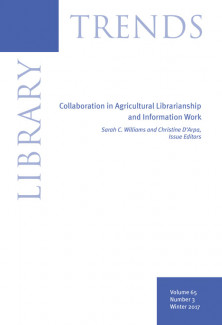
Johns Hopkins UniversityEst. 1876
America’s First Research University
Agricultural Partnerships Paying Off for Libraries

In 1990, Library Trends dedicated a special issue to the topic of libraries and agricultural information. After almost three decades, the journal revisited the topic in the third issue of the current volume.
Guest editors Sarah C. Williams and Christine D’Arpa, both from the University of Illinois at Urbana-Champaign, pulled together a collection of 11 essays which highlight the changes in agricultural information work, especially in regards to the cooperative or collaborative nature of the field.
Williams and D’Arpa joined us for a Q&A about the issue.
The last time Library Trends focused on agricultural libraries and information was 1990. What spurred you to take a new look at the topic?

Chris: Agricultural work is a critical component of the economy and remains a major focus of research at land grant universities in the United States. The libraries of those institutions – the librarians and the collections – have been important partners and resources for that research. The University of Illinois collections for agricultural information resources are especially deep both topically and historically and proved valuable to my dissertation research on the development of agricultural information work at the newly established U.S. Department of Agriculture in the second half of the 19th century. The 1990 issue of Library Trends helped me understand how library and information services for agricultural research looked a century after the USDA secured cabinet-level status in the U.S. government. The changes in the scope of agricultural information work and research and new technologies that helped to facilitate cooperation and collaboration discussed in that issue were sufficiently suggestive that I wanted to know where we stood nearly a quarter of a century later.
Collaboration plays a big role in the essays in the issue. What is so special about partnerships in this area?
Editors: Partnerships in agricultural librarianship and information work happen at many different levels, as illustrated by the articles in this issue. Librarians work with graduate students in a teach-the-teacher model to deliver information literacy skills to undergraduates in an agricultural science course, and librarians work with teaching faculty to offer a Scientific Writing Workshop to agricultural graduate students. Of course, librarians also collaborate with each other, whether within an institution to publish society publications via the Open Journal System, or across institutions to preserve and provide access to historical agricultural literature. In the field of agricultural librarianship and information work, opportunities exist for even broader partnerships, including with the Extension Service, the National Agricultural Library, the U.S. Department of Agriculture, and international initiatives like Research4Life. Agricultural information professionals can get involved at one or more of these levels and make significant contributions to improve the landscape of agricultural information, which is of worldwide importance.
What did you learn in putting the issue together?
Sarah: I have had a connection to agriculture throughout my entire professional career; yet, after working with my co-editor Chris, whose dissertation examines the information functions of the U.S. Department of Agriculture from 1862-1888, I now consider from time to time how my work as a practitioner fits into the larger picture of agricultural information. What a valuable lesson! Chris provided brief historical context in our issue Introduction, which might be helpful for other agricultural information practitioners to consider.
Chris: It is no coincidence that this current issue of Library Trends is itself the result of collaboration. I am grateful Sarah Williams agreed to co-edit the issue. Her experience and her professional connections were critical to the success of this issue. We approached the work for it knowing that collaboration in the area of agricultural information work and research has a long history. We learned that continued success depends on a network of individuals and organizations – local, regional, national – sharing knowledge and resources. We learned that cooperation and the collaborations that grow from it are essential to the vitality and significance of agricultural research in the public interest.
How can the information in this issue move things forward for agricultural constituents and libraries?
Editors: This issue reflects the breadth and depth of agricultural librarianship and information work and the role of collaboration in this field. We hope it inspires current agricultural information professionals to build new partnerships and strengthen existing partnerships. By publishing outside of typical science librarianship journals, we also hope this issue introduces other information professionals to the exciting opportunities related to agricultural information. Perhaps it will spark new individuals to explore preservation of agricultural publications, accessibility of agricultural data, publishing needs of small agricultural societies, or information needs of researchers and farmers in the developing world. Efforts like these will yield great benefits for agricultural constituents and libraries.


